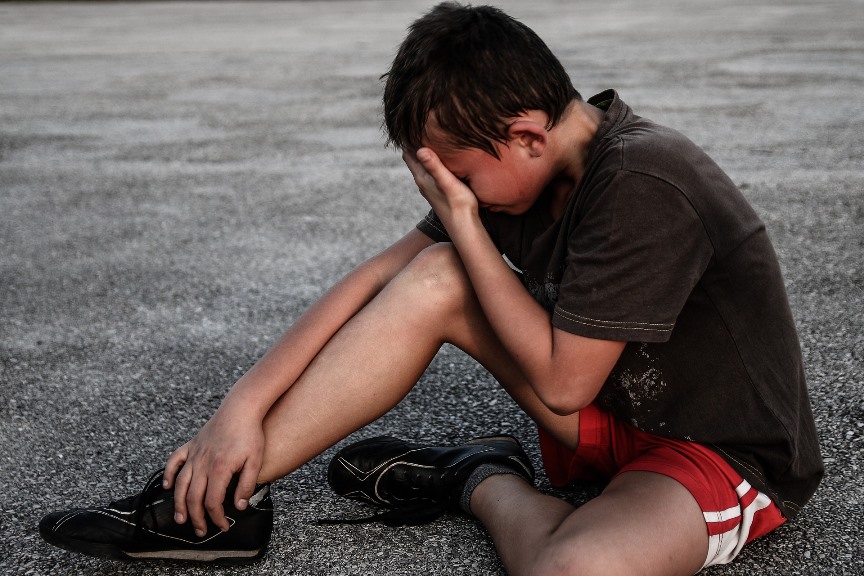“He passed away.”
“She’s sleeping and won’t wake up.”
Many parents avoid the topic of death with their children. It’s uncomfortable, sad, and often traumatic for a child to see or experience death first-hand.
You want to keep your child in a safe bubble. But sometimes that bubble pops – and your child needs to understand what death is and how to cope healthily.
You don’t need to wait till your child loses a loved one to talk about death. Death can be a topic of conversation at any point you feel your child is ready.
How Children Understand Death

How you address death should change depending on your child’s stage of development. Here is a helpful chart to understand how children view death as they learn more about life:
Ages 3-5 – Death is temporary, and they aren’t personally affected by a death.
Ages 5-9 – Death is final, but they still don’t connect personally with death. Nightmares often begin at this age.
Ages 9-13 – Death is irreversible, and even they will die one day.
7 Ways to Help Your Child Cope with Death
Here are seven ways you can address death with your child when you feel the time is right.
1. Use Clear Terminology
Death is a complex topic that even many adults have trouble agreeing on. Using vague terms is going to confuse your child even more. Don’t be afraid to use simple, straightforward terminology to explain death.
“Grandma died.”
Explain death using terms and images they understand.
“When someone dies, they don’t breathe or eat anymore.”
As you use terms, explain the “why.” Why did they die? Why won’t they come back?
If you tell them someone died because they are old, also explain some young people die. If someone died because they were sick, specify the type of sickness, or your child might associate all sickness with death.
If you’re religious, you can use terms like “heaven” to explain death – then follow through with explaining your belief. But, avoid using those terms if your family isn’t religious because it only confuses your child further.
2. Take Time to Listen to Your Child
After explaining death to your child, give time for your child to express their emotions and ask questions. Try not to avoid any questions they ask.
While some questions are uncomfortable – especially if you don’t even understand – try your best to explain. Saying “I don’t know” is an answer as well. Your child needs to hear and see that sometimes we can’t understand things – and that’s ok.
Fully listen to your child express their feelings. Try to avoid phrases that make them feel like their feelings aren’t acceptable.
“Grandpa would want you to be a big girl and not cry.”
“Be strong for Aunt Susie.”
Instead, allow them to acknowledge and express their reaction to a death.
“We all feel sad in different ways. It’s ok to cry.”
3. Help Your Child Define and Accept Their Emotions
After you explain death to a child, they might not know how they feel. Unknown emotions are overwhelming and can result in confusion, anger, or terror.
Help your child find ways to express their emotions about death. You can give examples of ways you feel when you hear someone died.
“When my grandma died, I felt very sad. But, I also felt angry because I didn’t want my grandma to leave me.”
Giving your child terms to use helps them grasp what they are feeling and know how to let others know so you can help them process those complex feelings.
4. Explain Details about What Happens Next
Death itself is only part of what your child will see and experience after a loss. Don’t stop by explaining death – continue talking about what happens next.
Go through the practical steps of what happens to a body, burials versus cremations, what a funeral is, and how people spend time grieving afterward.
Watching videos or seeing pictures of funerals may help your child understand the process and be more prepared when the time comes.
5. Allow Your Child to Participate
You may be explaining death to your child because they have lost someone personally. If this is the case, find a way to involve your child in the funeral or grieving process. Here are several ways your child can be involved.
- Picking out flowers for the grave
- Performing a reading or song at the funeral
- Choosing pictures from their loved one’s life to display
- Writing a message to the deceased
6. Find Ways to Remember a Loved One
Grief is not a process that follows the same steps for everyone – and it doesn’t end when the funeral or memorial is over. Grief takes time. Don’t rush your child’s process of grief.
One way to help your child through the grief process is to give them ways to remember their loved one. You can show your child they can talk about a person even if the person is dead. Share pictures, stories, and favorite songs with each other.
Another great way to help remember a loved one is to create a memorial. Some families plant memorial gardens together or create a memorial shelf. You can also buy cremation jewelry for ashes to keep your loved one close to your family.
7. Take Time to Heal After a Loss
Don’t rush your child back into their routine after a loss. Suppressing emotions only temporarily buries those feelings. Give your child space and time to accept grief and go through their journey of acceptance.
If your child needs time, don’t hesitate to take them out of school for a day. Give them mental health days if you notice them starting to struggle through emotions again.
Some great mental health day ideas are going out for ice cream where they can talk through their emotions, spending a spa day getting nails done to help them unload stress, or staying home and watching movies so they can find comfort in the familiar.

Seek Professional Help
You don’t need to carry the burden of explaining grief on your own. Don’t hesitate to reach out to mental health professionals to talk with your child about their feelings. The best way to help your child is to just be there for them.



